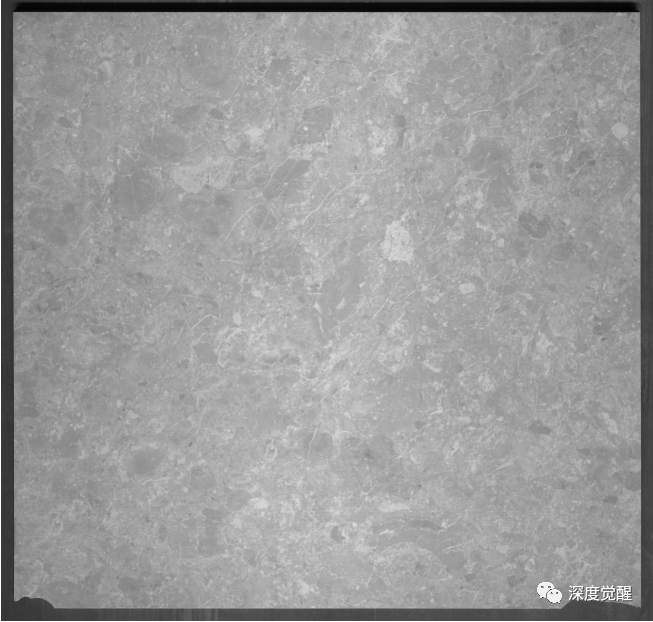❝最近在“2021广东工业智造创新大赛 智能算法赛:瓷砖表面瑕疵质检” 中遇到一些图片,有不同角度偏差。类似卫星图,分辨率特别大,目标却特别小,这就需要对原始图片自动调整角度,划窗剪裁和相应的坐标映射。
❞
读取图片
对于大图片来说,直接使用cv2.imread会比PIL再转numpy array慢 30% 左右,这里推荐使用Image.open读取。
import numpy as np
import cv2
from PIL import Image
# org_img = cv2.imread(BASE_DIR + img_file)
org_img = Image.open(BASE_DIR + img_file)
org_img = cv2.cvtColor(np.asarray(org_img), cv2.COLOR_RGB2BGR)

检测外框
1. 转灰度图
# 灰度图
greyPic = cv2.cvtColor(org_img, cv2.COLOR_BGR2GRAY)
2. 对图像进行二值化操作
这里阈值采用平均像数值,可满足大多数场景,特殊场合下可以自己调整。
# threshold(src, thresh, maxval, type, dst=None)
# src是输入数组,thresh是阈值的具体值,maxval是type取THRESH_BINARY或者THRESH_BINARY_INV时的最大值
# type有5种类型,这里取0:THRESH_BINARY ,当前点值大于阈值时,取maxval,也就是前一个参数,否则设为0
# 该函数第一个返回值是阈值的值,第二个是阈值化后的图像
ret, binPic = cv2.threshold(greyPic, greyPic.mean(), 255, cv2.THRESH_BINARY)
3. 中值滤波
median = cv2.medianBlur(binPic, 5)

4. 找出轮廓
# findContours()有三个参数:输入图像,层次类型和轮廓逼近方法
# 该函数会修改原图像,建议使用img.copy()作为输入
# 由函数返回的层次树很重要,cv2.RETR_TREE会得到图像中轮廓的整体层次结构,以此来建立轮廓之间的‘关系'。
# 如果只想得到最外面的轮廓,可以使用cv2.RETE_EXTERNAL。这样可以消除轮廓中其他的轮廓,也就是最大的集合
# 该函数有三个返回值:修改后的图像,图像的轮廓,它们的层次
contours, hierarchy = cv2.findContours(median, cv2.RETR_CCOMP, cv2.CHAIN_APPROX_SIMPLE)
5. 获取最小外接矩形
maxArea = 0
# 挨个检查看那个轮廓面积最大
for i in range(len(contours)):
if cv2.contourArea(contours[i]) > cv2.contourArea(contours[maxArea]):
maxArea = i
hull = cv2.convexHull(contours[maxArea])
hull = np.squeeze(hull)
# 得到最小外接矩形的(中心(x,y), (宽,高), 旋转角度)
rect = cv2.minAreaRect(hull)
# 通过box会出矩形框
box = np.int0(cv2.boxPoints(rect))

调整图片角度
获取角度偏差,计算仿射矩阵,将外接矩形box的坐标进行变换。
center = rect[0]
angle = rect[2]
if angle > 45:
angle = angle - 90
# 旋转矩阵
M = cv2.getRotationMatrix2D(center, angle, 1)
h, w, c = org_img.shape
# 旋转图片
dst = cv2.warpAffine(org_img, M, (w, h))
# 坐标变换
poly_r = np.asarray([(M[0][0] * x + M[0][1] * y + M[0][2],
M[1][0] * x + M[1][1] * y + M[1][2]) for (x, y) in box])
裁剪图片
x_s, y_s = np.int0(poly_r.min(axis=0))
x_e, y_e = np.int0(poly_r.max(axis=0))
# 设置预留边框
border = 100
x_s = int(max((x_s - border), 0))
y_s = int(max((y_s - border), 0))
x_e = int(min((x_e + border), w))
y_e = int(min((y_e + border), h))
# 剪裁
cut_img = dst[y_s:y_e, x_s:x_e, :]

划窗分割
图片已经扶正后,就可以根据需要进行划窗分割。指定划窗大小,重叠比例和输出目录后,就能获取一堆小图片了。
def slice(img, img_file, window_l=1024, overlap=0.2, out_dir=""):
# 切割图片 生成文件 xxx_000_000.jpg
h, w, c = img.shape
step_l = int(window_l - window_l * overlap) # 步长
x_num = int(np.ceil(max((w - window_l) / step_l, 0))) + 1
y_num = int(np.ceil(max((h - window_l) / step_l, 0))) + 1
for i in range(x_num):
for j in range(y_num):
x_s, x_e = i * step_l, i * step_l + window_l
y_s, y_e = j * step_l, j * step_l + window_l
# 修正越界
if x_e > w:
x_s, x_e = w - window_l, w
if y_e > h:
y_s, y_e = h - window_l, h
assert w >= window_l
assert h >= window_l
new_img_file = img_file[:-4] + '_%03d_%03d.jpg' % (i, j)
im = img[y_s:y_e, x_s:x_e, :]
cv2.imwrite(out_dir + new_img_file, im)
return

批量化处理
封装一下函数,对整个目录扫描,并保存和原图的对应关系配置文件,为之后还原坐标做准备。
def adjust_angle(org_img, img_file, border=100):
h, w, c = org_img.shape
# 统一尺度,如果尺寸小于 4000,放大一倍
scale = 1
if w < 4000 or h < 4000:
scale = 2
w = int(w * scale)
h = int(h * scale)
org_img = cv2.resize(org_img, (w, h), interpolation=cv2.INTER_LINEAR)
x_s, y_s, x_e, y_e, rect, new_img = getCornerPoint(org_img)
# 去除边框
x_s = int(max((x_s - border), 0))
y_s = int(max((y_s - border), 0))
x_e = int(min((x_e + border), w))
y_e = int(min((y_e + border), h))
img = new_img[y_s:y_e, x_s:x_e, :]
data = dict()
data['name'] = img_file
data['xyxy'] = [x_s, y_s, x_e, y_e]
data['rect'] = rect
data['border'] = border
data['scale'] = scale
return data, img
设置BASE_DIR为原图目录,OUT_ADJUST为角度调整后目录,adjust.json为配置文件。
result_json = []
img_list = os.listdir(BASE_DIR)
for img_file in tqdm(img_list):
org_img = Image.open(BASE_DIR + img_file)
org_img = cv2.cvtColor(np.asarray(org_img), cv2.COLOR_RGB2BGR)
data, img = adjust_angle(org_img, img_file, border=100)
result_json.append(data)
cv2.imwrite(OUT_ADJUST + img_file, img)
slice(img, img_file, TARGET, overlap=OVERLAP, out_dir=OUT_SLICE)
with open(OUT_DIR + 'adjust.json', 'w') as fp:
json.dump(result_json, fp, indent=4, ensure_ascii=False)

坐标还原
1. 读取切片图片列表
with open("instances_test2017_1024.json", 'r') as f:
test_imgs = json.load(f)['images']
test_imgs_dict = {}
for i, obj in enumerate(test_imgs):
img_name = obj['file_name']
test_imgs_dict[img_name] = i
2. 读取原始文件信息
with open(OUT_DIR + 'adjust.json', 'r') as fp:
img_info = json.load(fp)
img_info_dict = {}
for i, obj in enumerate(img_info):
img_name = obj['name']
img_info_dict[img_name] = i
3. 读取推理结果文件
将一堆子图的推理结果放到一起,可以充分利用mmdetection的多线程DataLoader和大显存的batch size来加速推理过程。
with open("result_1024-20.pkl", 'rb') as f:
pred_set = pickle.load(f)
4. 合并坐标到角度调整图
获取到图片长宽,根据相同的划窗参数,可以还原出每个子图的基准坐标x_s和y_s。
其中test_imgs_dict中保存了子图的文件名字典,pred_set保存了预测结果列表。通过形如XXX_000_000.jpg的文件名,经过两级映射后就能获取到对应的推理结果集了。
def merge_result(info, pred_set, test_imgs_dict, img_file, window_l=1024, overlap=0.2):
assert info['name'] == img_file
# 这里只需要取图片长宽信息,避免读图操作太慢,直接读取配置文件
x1, y1, x2, y2 = info['xyxy']
w = x2 - x1
h = y2 - y1
step_l = int(window_l - window_l * overlap) # 步长
x_num = int(np.ceil(max((w - window_l) / step_l, 0))) + 1
y_num = int(np.ceil(max((h - window_l) / step_l, 0))) + 1
result = [np.array([[], ] * 5).T.astype(np.float32), ] * 6 # 分类数为6, bbox.shape 为(0, 5)
for i in range(x_num):
for j in range(y_num):
x_s, x_e = i * step_l, i * step_l + window_l
y_s, y_e = j * step_l, j * step_l + window_l
# 修正越界
if x_e > w:
x_s, x_e = w - window_l, w
if y_e > h:
y_s, y_e = h - window_l, h
assert w >= window_l
assert h >= window_l
new_img_file = img_file[:-4] + '_%03d_%03d.jpg' % (i, j)
pred = pred_set[test_imgs_dict[new_img_file]] # 获取预测结果
for label_id, bboxes in enumerate(pred):
# 坐标修正 x_s, y_s 划窗基坐标
bboxes[:, 0] = bboxes[:, 0] + x_s
bboxes[:, 1] = bboxes[:, 1] + y_s
bboxes[:, 2] = bboxes[:, 2] + x_s
bboxes[:, 3] = bboxes[:, 3] + y_s
# 合并到大图
result[label_id] = np.vstack((result[label_id], bboxes))
return result

5. 坐标映射到原图
首先获取到原图信息info,获取外接矩形参数、旋转角度、缩放比例、边框大小等等,构建一个逆仿射矩阵M,对所有检测框进行坐标变换。
def generate_json(pred, info, img_file, score_threshold=0.05, out_dir="", vis=False):
base_x, base_y, x2, y2 = info['xyxy']
rect = info['rect']
scale = info['scale']
border = info['border']
x1, y1, x2, y2 = (border, border, x2 - border, y2 - border)
poly = np.asarray([(x1, y1), (x2, y1), (x2, y2), (x1, y2)])
center = tuple(rect[0])
angle = rect[2]
if angle > 45:
angle = angle - 90
# 逆旋转还原
M = cv2.getRotationMatrix2D(center, -angle, 1)
# 遍历完所有分片, nms
json_results = []
for label_id, bboxes in enumerate(pred): # 6个分类
bboxes = nms(np.array(bboxes[:, :4]), np.array(bboxes[:, 4]), iou_threshold=0.5)[0]
# 坐标转换到原始图片
bboxes[:, 0] = bboxes[:, 0] + base_x
bboxes[:, 1] = bboxes[:, 1] + base_y
bboxes[:, 2] = bboxes[:, 2] + base_x
bboxes[:, 3] = bboxes[:, 3] + base_y
for ann in bboxes:
x1, y1, x2, y2, score = ann
if score < score_threshold:
continue
poly_r = np.asarray([(M[0][0] * x + M[0][1] * y + M[0][2],
M[1][0] * x + M[1][1] * y + M[1][2]) for (x, y) in
[(x1, y1), (x1, y2), (x2, y1), (x2, y2)]])
# 还原小图片缩放
ann = poly2ann(poly_r, score, scale=scale)
data = dict()
data['name'] = img_file
data['category'] = label_id + 1
data['bbox'] = [float(ann[0]), float(ann[1]), float(ann[2]), float(ann[3])]
data['score'] = float(score)
json_results.append(data)
return json_results
最后经过nms和一系列后处理之后,映射到原图上即可。

完美收工!